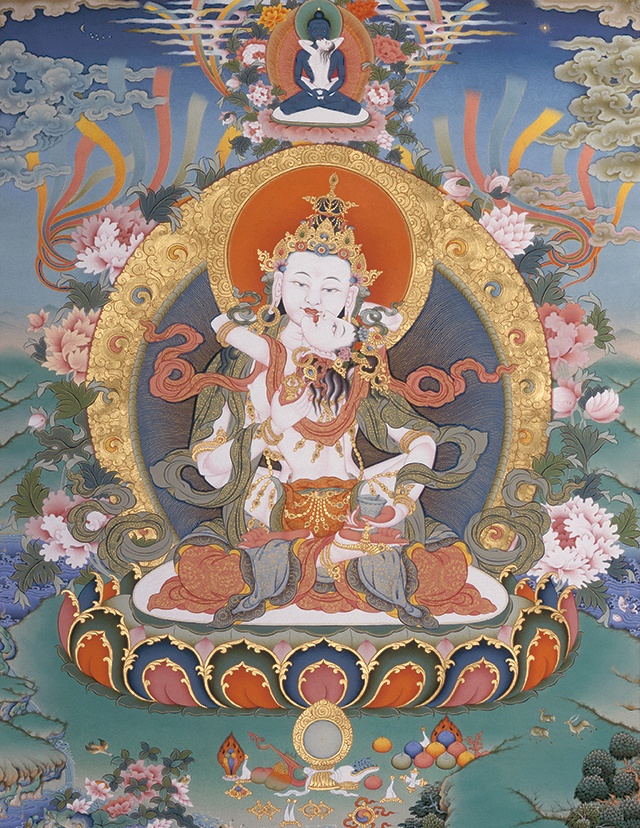Who is Vajrasattva?
Vajrasattva stands as a prominent figure within Mahayana Buddhism, embodying the essence of purification and enlightenment. Often depicted as a white deity adorned with jewels, Vajrasattva holds the vajra, symbolizing indestructible purity, in one hand and a bell, representing wisdom, in the other.
The Practice of Vajrasattva
The Vajrasattva practice holds significance across all four main schools of Tibetan Buddhism—Gelug, Kagyu, Sakya, and Nyingma. Central to this practice is the recitation of the Vajrasattva mantra, a potent tool for purifying obstacles, delusions, and negative karma.
The 100-Syllable Mantra
The Vajrasattva mantra serves as a beacon of purification, guiding practitioners towards inner transformation and spiritual growth. Its recitation is accompanied by visualization and concentration on the four opponent powers. At the heart of the Vajrasattva practice lies the 100-syllable mantra, revered for its transformative power. Reciting this mantra involves engaging the body, mind, and speech in a harmonious symphony of purification.
OM VAJRASATTVA SAMAYA MANUPALAYA
VAJRASATTVA TVENOPATISHTHA
DRIDHO ME BHAVA
SUTOSHYO ME BHAVA
SUPOSHYO ME BHAVA
ANURAKTO ME BHAVA
SARVA SIDDHIM ME PRAYACCHA
SARVA KARMA SU CHAME
CHITTAM SHRIYAM KURU HUM
HA HA HA HA HO
BHAGAVAN SARVA TATHAGATA
VAJRA MAME MUNCHA
VAJRA BHAVA MAHA SAMAYA SATTVA
AH HUM PHAT
Mantra’s Meaning:
The Vajrasattva mantra holds deep significance in Tibetan Buddhist practice, representing the essence of purification and transformation. Here’s a breakdown of its meaning:
- OM VAJRASATTVA: “Om” is a sacred syllable representing the essence of the universe. “Vajrasattva” refers to the enlightened form of Vajra, symbolizing indestructible purity and wisdom.
- SAMAYA MANUPALAYA: This part of the mantra invokes the commitment to maintaining the vows and pledges associated with the practice. It signifies a promise to uphold the ethical conduct and principles of the spiritual path.
- VAJRASATTVA TVENOPATISHTHA: Here, the practitioner calls upon Vajrasattva to be firmly present and established in their being. It signifies a deep connection with the enlightened qualities embodied by Vajrasattva.
- DRIDHO ME BHAVA, SUTOSHYO ME BHAVA, SUPOSHYO ME BHAVA, ANURAKTO ME BHAVA: These lines express the practitioner’s aspiration to embody various qualities associated with enlightenment, such as stability, satisfaction, nourishment, and devotion.
- SARVA SIDDHIM ME PRAYACCHA: The practitioner requests for the bestowal of all accomplishments and attainments, both worldly and spiritual, by Vajrasattva.
- SARVA KARMA SU CHAME: This line seeks purification of all negative karma accumulated through actions of body, speech, and mind.
- CHITTAM SHRIYAM KURU HUM: The practitioner implores for the purification and enhancement of their consciousness and wisdom.
- HA HA HA HA HO: These syllables represent the laughter of the Buddhas, signifying joy, liberation, and the transcendence of suffering.
- BHAGAVAN SARVA TATHAGATA: This line pays homage to all the enlightened Buddhas, acknowledging their omniscient and compassionate nature.
- VAJRA MAME MUNCHA, VAJRA BHAVA MAHA SAMAYA SATTVA, AH HUM PHAT: These concluding phrases invoke the empowerment and blessings of Vajrasattva, sealing the practitioner’s connection with the enlightened qualities and energies represented by the vajra.
How to Recite the Mantra?
- Memorization: Learn the mantra by heart.
- Posture: Maintain a relaxed yet upright position.
- Visualization: Envision Vajrasattva and the purifying light.
- Concentration: Recite the mantra with full focus.
- Purification: Visualize the purifying nectar cleansing body, speech, and mind.
- Commitment: Resolve to abstain from negative actions in the future.
Repetition and Purification
For each purification practice—Body, Speech, and Mind—repeat the mantra 21 times, harnessing its transformative energy to cleanse and renew.
The Five Aggregates
Integral to Buddhist philosophy is the concept of the five aggregates, or skandhas, which Vajrasattva’s practice seeks to purify:
- Form: The material aspect or body.
- Sensation: Sensory experiences or feelings.
- Perceptions: Comprehension and processing of stimuli.
- Mental Formations: Karmic activities and conditioning.
- Consciousness: Awareness and discrimination.
The Four Opponent Powers
Integral to the Vajrasattva practice are the Four Opponent Powers, guiding practitioners towards genuine repentance and purification.
- Power of Regret: Reflect on past negative actions with sincerity.
- Power of Remedy: Utilize the mantra and visualization for purification.
- Power of Reliance: Seek refuge in the Three Jewels—Buddha, Dharma, and Sangha.
- Power of Promise: Commit to avoiding negative karma in the future.
Conclusion
Vajrasattva stands as a luminous embodiment of purity and transformation, offering practitioners a path towards inner liberation and enlightenment. Through the practice of reciting the mantra and embracing the Four Opponent Powers, one can embark on a journey of profound purification and spiritual awakening.



